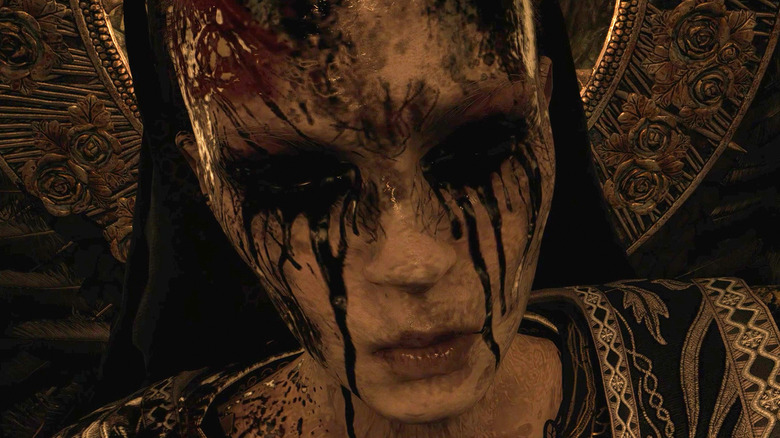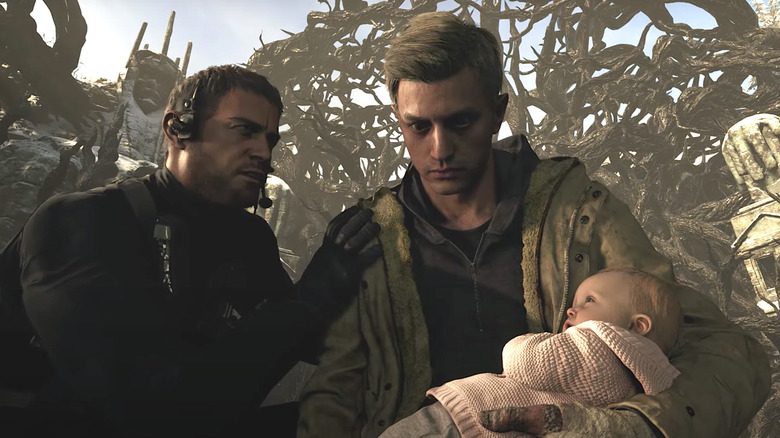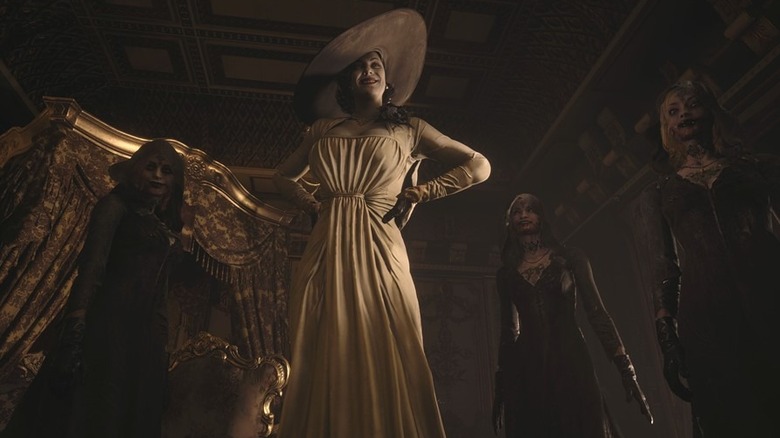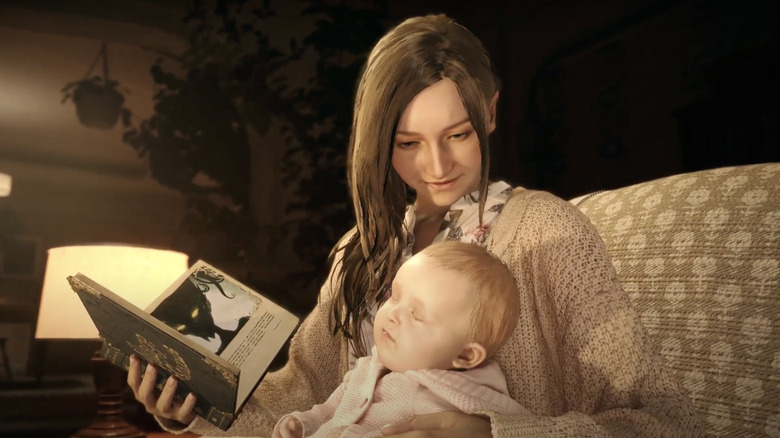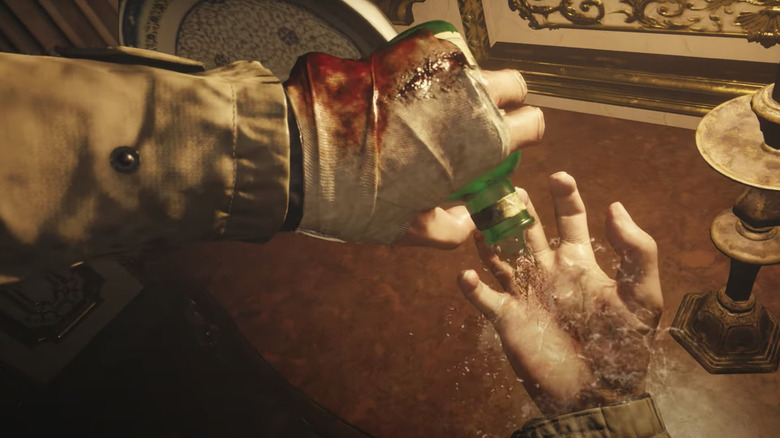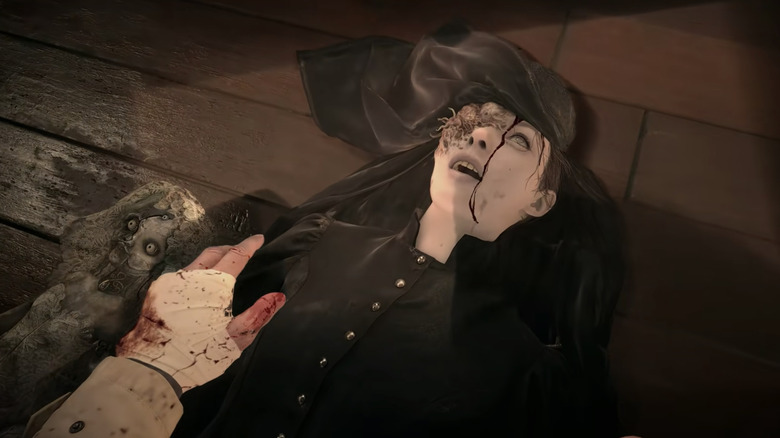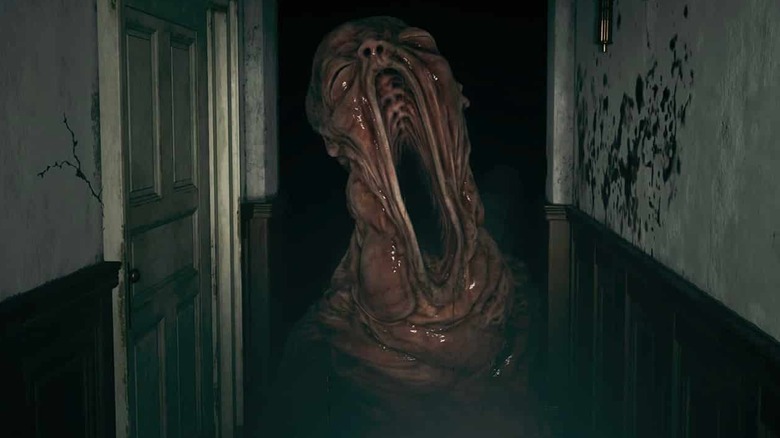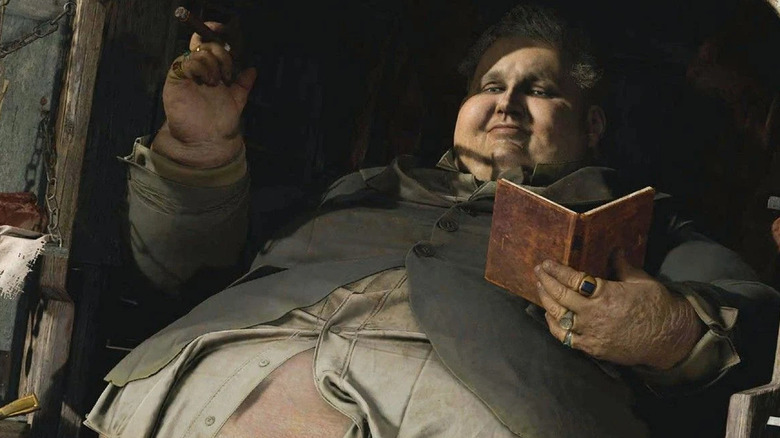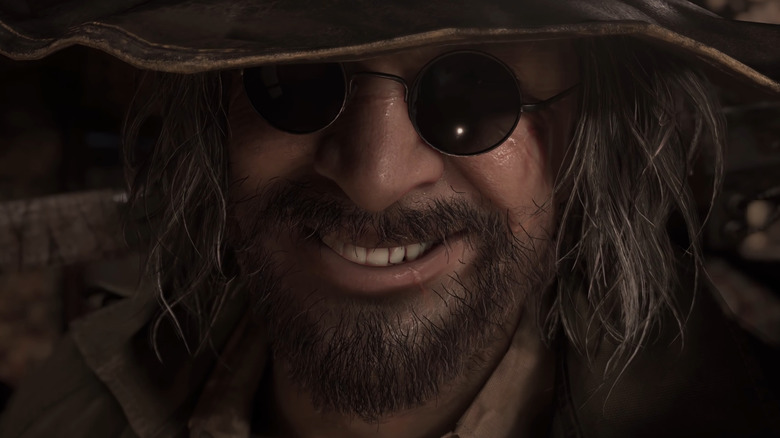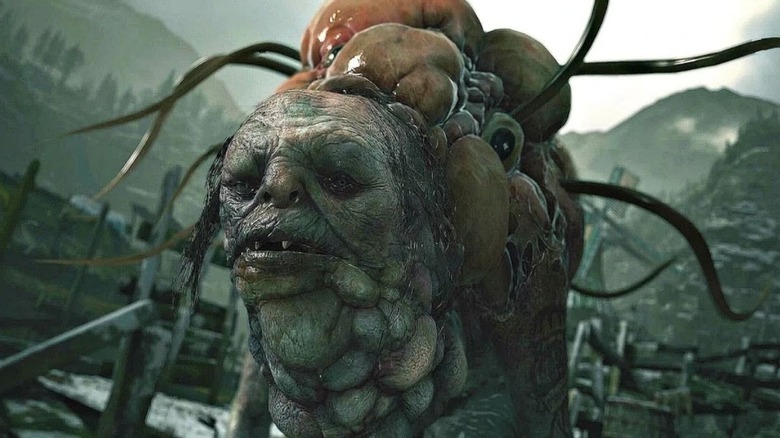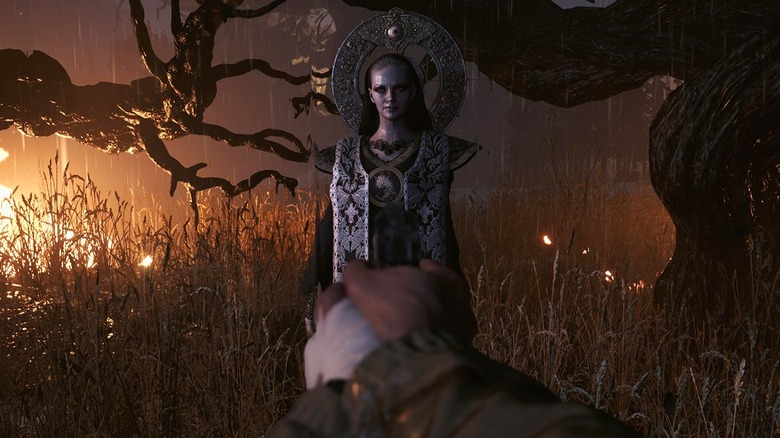Things Only Adults Notice In Resident Evil Village
The whole of the "Resident Evil" franchise is a gaming staple, with its debut release defining many of the tropes that would go on to define the survival horror genre, especially in its early days. And while more recent titles in the long-running series have begun to shy away from some of their predecessors' more draconian mechanics — like pre-rendered backgrounds and those pesky "tank" controls — newer entries still hold onto what made older iterations so much nightmarish fun.
"Resident Evil Village," the latest entry in Capcom's beloved franchise, is no exception to this fact. It combines nail-bitingly intense action reminiscent of the more combat-oriented "Resident Evil 4" with labyrinthine exploration that recalls the sense of awe that OG "Resident Evil" players felt exploring Spencer Mansion for the first time. But while some gamers might have nostalgic memories of playing early "Resident Evil" games in all of their campy, pixelated beauty, "Resident Evil Village" is another step in a far more mature direction that arguably began with "Resident Evil 7: Biohazard." Gone are the Jill Sandwiches and boulder-punching beefcake protagonists. "Village" wears its "M" rating proudly.
From its mutilated monsters and gruesome, gore-strewn set pieces to Ethan Winters' proclivity for dropping the occasional F-bomb, "Resident Evil Village" isn't exactly a child-friendly game, and that's a distinction that extends to many of the game's prominent themes and plot points, as well.
Beware of major spoilers ahead for "Resident Evil Village."
Ethan Winters, father of the century
"Resident Evil Village" isn't the first mainstream survival horror game to slip players into the sensible shoes of an everyman dad type. That honor may go to Harry Mason — protagonist of Konami's equally influential "Silent Hill," (a game that you should never play before bed, by the way). That said, Ethan Winters still goes above and beyond in his daddy duties, infiltrating some of the darkest recesses of Eastern Europe in search of his missing daughter, Rosemary.
Ethan's role in "Village" represents more than just a random branch of the Winters family tree. Rather, it represents one of the game's most prevailing themes: what it means to be a parent and the sacrifices that come with being one. Ethan literally disrupts an entire cadre of lords, losing fingers, buckets of blood, and even his actual heart in the process.
Sure, your typical parent doesn't hunt mutated monstrosities on the reg or boast the ability to re-attach their limbs on a whim. But, if it meant returning their children to safety, many moms and dads would go through hell and back, regardless of how many extremities they'd lose in the process. Now, that's good parenting.
Village is filled with powerful mothers
In "Resident Evil Village," the theme of parenthood doesn't end with Ethan Winters' quest to save his daughter, Rosemary. In fact, maternity might play an even larger — and more visible — role throughout the game. While Mia Winters' role in "Village" is considerably smaller than the terrifying part she played in "Resident Evil 7," her assumed murder at the hands of Chris Redfield and the Hound Wolf Squad kickstarts Ethan's perilous journey into the game's titular village.
Visually, "Village" is chock-full of symbolism related to motherhood and childbirth, from the Megamycete's resemblance to a growing fetus to the grotesque "Baby" monster — one of the creepiest things players found in "Village."
Then there's the twisted Mother Miranda, a woman who, despite doing some seriously messed-up stuff to the Winters family, is motivated solely by her love for her long-dead daughter, Eva, whom she seeks to resurrect via the "vessel" of Rosemary. And who can forget about the game's other malicious maternal figure, the towering Lady Dimitrescu? Although she's quite literally out for blood, her main priority throughout the events of "Village" is the safety and well-being of her vampiric "daughters."
Strong mothers and overt representations of motherhood and childbirth abound in "Resident Evil Village," although most of them might go over the heads of younger players.
Bodysnatchers? Mama Mia!
It's time to address the elephant in the room. It's revealed towards the end of "Resident Evil Village" that the woman cooking Ciorbă de legume at the start of the game was Mother Miranda, not Mia Winters. Somehow, one of the strangest things about a game in which a man mutates into a massive fish-monster is that Miranda used the power that she gained after being infected by Mold to shape-shift into Mia and infiltrate the Winters household.
This poses all sorts of ethical questions regarding the kidnapping of the real Mia Winters. It also, however, has forced players to consider the fact that Ethan has been shacking up with a murderous, mutated stranger for at least a few days (as dug up by Redditor u/LordScyther998). Mother Miranda-as-Mia, heretofore known as "Mia-randa," only seemed to act "off" when Ethan brought up the Dulvey Incident — the events that took place during "Resident Evil 7." This would seem to suggest that there was nothing else truly strange about Mia-randa, meaning life in the Winters household basically went on as usual.
Let's not mince words here: If any romantic shenanigans were going down in the Winters household in the days between when Miranda replaced Mia and Mia-randa's failed assassination, Ethan would have thought he was with his actual wife. It's a very, very icky thought — and one that's definitely meant for adult minds only.
Healthcare, Resident Evil style
Healing items and action-oriented video games go together like carrots and peas, with most "Resident Evil" protagonists relying on good ol' herbs and first aid spray to heal up after a brutal zombie beatdown. Ethan Winters, however, seems to prefer the just-as-vaguely-named "First Aid Med" — y'know, those bottles of crap he pours all over his hands to magically fix 'em right up.
It's easy to assume that First Aid Meds are a kind of cure-all, similar to potions out of a fantasy RPG like "Skyrim," especially considering that these mystery bottles' in-game description claims that the medicine inside "fully heals all wounds." The description adds that it "closes gashes and acts as a clotting agent while restoring function to damaged systems." Interestingly, though, "Resident Evil Village" does something interesting with its healing mechanic: It ties it directly into the game's narrative.
As is heavily implied by the "Infection Report" found at the end of "Resident Evil 7," Ethan's ability to "coapt the amputated limbs in a matter of minutes" is a direct result of his exposure to the Mold. The report explains that the "infected subject" — in this case, Ethan — "gains remarkable regenerative abilities," strongly suggesting that Ethan's ability to heal wounds, survive being impaled, and re-attach his hand has little to do with First Aid Meds and a helluva lot more to do with his status as a Molded. While younger players may take the meds' effects at face value, older fans will appreciate the narrative aspects of the healing item.
The tragedy of Donna Beneviento
Donna Beneviento is an underrated character in "Resident Evil Village." Players barely get a look at the puppeteer's face underneath her funeral veil, and she boasts but a single line of dialogue in the entire game. Still, Ethan's venture into the Beneviento house is a stand-out section of "Village," eschewing over-the-top action for a hallucinatory trip into a hellish psychological nightmare.
While Donna is by no means an innocent bystander, she appears far more tortured by her own demons than agitated by the American guy running around. The reason? She very well might be suffering from severe depression — and she just might envy the fact that Ethan has a real family.
Based on the little information about Donna's personal life that players are privy to, she lost her sister Bernadette and both of her parents at a young age. It's also heavily suggested that she also lost a much younger sister, Claudia, as shown by the grave at the center of the Beneviento Treasure hunt (though fans think Claudia could also be her daughter). Finally, upon retrieving the photo slipped into the door at the start of the Beneviento House section, the back of it reads, "Take care of our little Rose," implying that Donna may have seen her as something of a surrogate daughter.
The heartbreaking sadness of losing a family and shrinking into despair, literally hiding behind a symbol of happiness like the doll Angie, is a mature concept that younger players might quickly gloss over.
This baby has a face not even a mother could love
No discussion of the House Beneviento section of "Resident Evil Village" is complete without an audible scream-turned-retch upon first sight of the infamous "Baby" monster. Superficially resembling the result of an absentminded scientist fusing his own body with a life-sized gummy bear in a teleportation pod, this abomination exists solely within Ethan Winters' mind. It's nothing more than a hallucination brought on by the combination of Donna's super-powered pheromones and pollen from plants exposed to the Megamycete. Basically, she sends Ethan rocketing through a truly crappy drug trip.
This all makes sense, in a "Resident Evil" sort of way — with the exception of one aspect of the malignant monster child. The Baby, who chases poor Ethan through the Beneviento House, can kill Ethan if he doesn't follow a specific escape route, devouring him while uttering a morbidly hilarious "Yummy!" This begs a big and gooey question: Just who, or what, is actually "eating" Ethan? How is he succumbing to death by hallucination? Is this nothing more than a cardiac arrest — something that makes little sense, given Ethan's later ability to literally survive without a heart? These are the kinds of questions that keep adult gamers awake at night.
Steal from the dead to give to yourself
Most modern action-adventure titles feature merchants or shops where players can exchange treasures they've obtained during their journey for some well-deserved cashola. "Resident Evil Village" is no exception to this trope, but it spices things up a bit by making one big, weird change to the tried-and-true formula. While Ethan can collect actual treasure — things like necklaces, dolls, and other valuable trinkets — he can also peddle the crystalized remains of his enemies. Some might call this practice "grave robbery," but, hey, that's capitalism.
Of course, there's nothing too weird about pawning off the skull of a werewolf. After all, hunters and trappers do that sort of thing all the time. But it's very clear very early on that the creepy, crawly critters populating the titular village — and, eventually, Ethan's sack of treasures — were once (possibly very recently) humans just like him.
Even more disturbing is the fact that many of Ethan's fancy new "treasures" were characters he'd had full-on conversations with, like Lady Dimitrescu and Salvatore Moreau. It just goes to show you, kiddies: Having arch-enemies who want to empty your body of all its blood pays off when you can sell their corpses to buy a bigger backpack.
Heisenberg might have a messed-up origin
Of all of the locales Ethan traverses in "Resident Evil Village," Karl Heisenberg's factory is the most cold and clinical. In the steampunk lord's efforts to overthrow Mother Miranda's oppressive grip on his life, Heisenberg aimed to build an army of mindless, killer weapons — part man, part machine, all devastatingly deadly.
With German names like Soldat Eins, Zwei, Jet, and Panzer — in addition to the cruel and experimental measures to which the men were likely subjected — it's hard not to see similarities between Heisenberg's Factory and the laboratories where real-life Nazis performed nightmarish experiments on innocent victims. But there's another connection between Heisenberg and The Third Reich, and it has a whole lot to do with both the lord's name and his scientific proclivities.
Enter Werner Heisenberg, a German physicist and philosopher who was contracted by the Nazi party to consult on the possibility of creating a German atomic bomb. Eventually, the scientist was taken into American custody in the mid-40s and was tasked with helping Allied Forces determine Germany's atomic bomb-building progress.
Like Karl Heisenberg, a villain who was experimented on by Mother Miranda against his will, Werner was strong-armed into a position by representatives of an opposing ideology. With this fact, coupled with the similarities in name, occupation, and the inhuman treatment with which the "Resident Evil Village" villain treats his test subjects, comparisons can easily be drawn between the two scumbags.
Does baby Salvatore want his binky?
Donna Beneviento might be a psychotic — if tragic — member of Miranda's inner-circle, but at least she's got her looks (even if she hides them, like, 24/7). Unfortunately, the same cannot be said for the second most tragic figure in "Resident Evil Village."
Real talk: Salvatore Moreau is a monstrosity of a man, with bulbous pustules decorating his lumbering, hunchbacked frame and nematodes (parasitic worms) occasionally popping out from his back, wriggling like streamers dancing in a fan's breeze. His penchant for throwing up his lunch isn't so pretty either.
That said, it's hard not to feel pity for someone so, well... pitiful. Obviously not the sharpest tool in the shed, and by no means a paradigm of physical strength or beauty, Moreau was coerced into servitude by Mother Miranda. He wasn't even given a proper house like Lady D or a laboratory like Heisenberg. And yet, despite all of this, Moreau is unwavering in his commitment to his cultist "mother," frequently admitting how badly he wants to make her proud. He even cries out to her in his last breath, begging her to save him before — POP!!
It would be so easy for less mature players to write Moreau off as just another monster. However, ignored right up until the end, Moreau exemplifies the craving for love that so many misfit characters feel toward their authority figures. And if that's not heartbreaking, then you must be Ethan Winters. (Get it?)
Trying to piece together Miranda's plan
Mother Miranda, resident evil scientist of "Resident Evil Village," had a really complicated plan. Basically, she kidnapped Mia Winters, infiltrated the Winters home, and abducted Rosemary from Chris after the failed assassination attempt. That's part one. Part two is even more complex and, dare we say, pretty dumb, as she dismembered little Rosemary Winters and then distributed her preserved body parts to her lords — Lady D, Moreau, Donna Beneviento, and Mr. Definitely-not-a-Nazi.
Miranda likely knew that these actions would inspire Chris Redfield and Ethan Winters to come a-knocking. But why cut Rosemary into pieces to begin with? Miranda obviously knew about Rose's regenerative abilities — this is why she saw her as the perfect vessel to resurrect her deceased daughter, Eva. But it still doesn't explain why she sliced her to pieces.
What part of Miranda's ritual to bring back Rose demanded that she be scattered into pieces like an ill-fated Jenga tower and then submerged into the Mold? And why the heck did Miranda think that some gobs of black goo would transform one person into an entirely different deceased person, let alone someone whose death had nothing to do with the Megamycete?
There are just too many questions that rise to the surface after the bombast of "Resident Evil Village" wears off. Here's hoping for some DLC that explains it all a teensy bit better.

